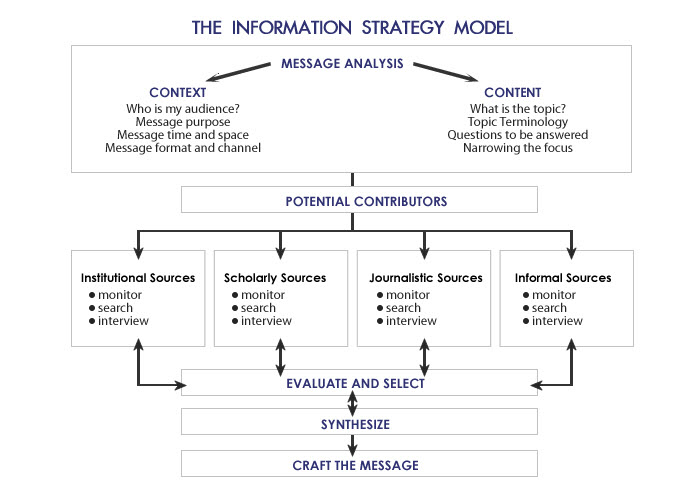16.1 Putting It All Together
Over the course of the semester we’ve examined the steps a communications professional must take when trying to tackle a new information task or message assignment.
These steps, by way of review, are:
-
clarify the parameters of the message assignment.
-
identify potential audiences.
-
generate ideas and bring focus to the topic.
-
understand the variety of potential contributors of information.
-
appreciate the ethical and legal considerations required.
These first steps of the process will help you generate a set of questions or information “tasks” that you will need to perform in order to create the required communication message. Thinking about the potential contributors that could provide information to complete those tasks or answer the questions will get you started on the information strategy process. Knowing the ethical expectations and how to craft a message that meets legal standards will help guide you as you find and select information to use.
We’ve also discussed the key skills researchers must hone to be efficient and strategic in their information strategy tasks. These skills are:
-
Searching: understanding how and where to locate both traditional repositories and databases of material and more esoteric or specialized resources, and constructing an effective search “equation” with appropriate keywords and utilizing search fields.
-
Interviewing: finding and “vetting” people from a variety of contributor types who might have information, insights, or perspectives on whatever you are searching and developing the techniques to best engage and elicit helpful responses from them.
-
Evaluating: knowing how to detect bias, misinformation, or unsubstantiated information you might find through searching or interviewing.
-
Managing and Synthesizing: developing techniques for keeping track of the information you locate, methods for synthesizing key points or ideas to generate new insights, and criteria for selecting (or discarding) the information you find.
Finally, we’ve discussed the forms in which information appears. We’ve looked at the tools, techniques and special requirements for understanding and using information from:
-
data and statistics
-
polls and surveys
-
public records
-
periodical publications
Now it is time to apply all of these skills and use the suite of resources for specific kinds of information requirements. Here’s how to apply all of these skills and resources. The following scenarios will step through the thinking process and track the information seeking path.
An information strategy is used throughout the message generation process. Here are the various stages at which communication researchers will need to locate information to complete the required tasks:
-
Initial idea generation or project focusing
-
Understanding the intended audience / who they are, what they do, where they are, how to reach them
-
Understanding an unfamiliar topic
-
Finding information from various types of contributors using different information gathering skills
-
Understanding what the information means and how to organize and synthesize it for your message task
In this lesson we will work through several specific communication task scenarios and detail the thought processes and research strategy used when:
-
analyzing the message needs
-
clarifying the audience to address
-
generating ideas and focusing on angles of a topic
-
finding information on the topic / angle from a variety of types of contributors
-
synthesizing and selecting material that was found

